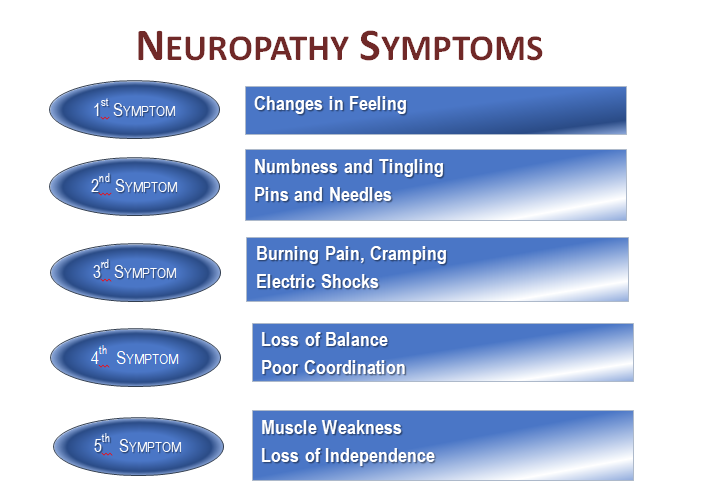
What is Peripheral Neuropathy?
Damage to peripheral nerves that interferes with vital connections from the brain, distorting and interrupting messages to the body.
What are peripheral nerves?
Nerves that are outside the brain and spinal column. The damage to the peripheral nerves can be from inflammation, injury, or disease. The body’s wiring system has gone haywire!
Causes for Peripheral Neuropathy:
- Diabetes
- Cancer
- Trauma
- Drug or Substance-Induced
- Nutritional Deficiency
- Liver or Kidney Disease
- Exposure to Toxins (Agent Orange & others)
- Infection

What do I do now?
You need an accurate diagnosis.
- Thorough History & Physical Examination
- Thorough history including medical, personal, occupational, military
- Neurological Sensitivity Testing
- Nerve Conduction Tests
- Electromyelography
- Skin or Nerve Biopsy occasionally necessary
Traditional Treatment-
Treat Underlying Disease:
- Control blood sugar
- Control blood pressure, kidney or liver disease
- Eliminate offending substance (statin drugs, alcohol, toxins)
- Correct vitamin deficiencies
Medications
There are only 3 FDA approved medications approved to treat PN.
- Lyrica (pregabalin)
- Cymbalta (duloxetine)
- Nucynta ER (tapentadol ER)
These can have serious side effects, often with little relief of neuropathy pain.
Other Medications are used “off label” to try to combat neuropathy pain:
Creams: Capsaicin, Biofreeze, Lidocaine -Often Ineffective
Pills: Gabapentin, Amitriptyline, Tegretol, Nortriptyline -Risky Side Effects
Narcotics: Tramadol, Oxycodone, Hydrocodone, Oxycontin -Dangerous and Addictive
Alternative Treatments
- Metanx *highlighted today*
- Platelet-Rich Plasma Injections to restore nerve tissue
- Physical Therapy to improve strength and balance, increase safety
- Life-style changes can address the root of the problem
Diabetic Peripheral Neuropathy
You’re alone! There are more than 29 million patients with diabetic peripheral neuropathy (DPN). DPN is the most common complication of diabetes affecting 69% of patients to experience painful burning, stabbing, throbbing, numbness and/or poor balance (Quan & Lin, 2014). Because traditional medications provide ineffective relief of this pain, Metanx, will be highlighted here.
Metanx
Diabetic nerves lose their density, interrupting messages between the body and the brain causing pain, numbness, and poor balance. The medical food, Metanx, increases the nerve density. Metanx is defined by the FDA as a medical food. It requires a prescription from your health care provider. Metanx comes in the form of a capsule that is taken twice a day. While Metanx has been available to manage DPN for many years, its’ availability is not widely known.
Metanx corrects physical nerve damage by increasing the nerve density and correcting chemical imbalances. Metanx contains:
- L-methylfolate Calcium 3 mg
- Pyridoxal-5´-Phosphate 35 mg

- Methylcobalamin 2 mg/L
A research study performed at Pivotal Health revealed great results. In a small eight week clinical study of patients with DPN (Christenson, 2015), Metanx effectiveness was verified:
- In 8 weeks of Metanx intake, every patient experienced a pain reduction! There was a 68% improvement in neuropathy pain.
- In 8 weeks of Metanx intake, there was a 45% reduction of neurologic symptoms.
- In 8 weeks of Metanx intake, patients experienced a 20% improvement in overall quality of life! This included a reduction in activity limitations and improved symptoms and emotions.\
Practical Interventions
- Be well-hydrated = at least 8 -8 ounce glasses of water/day (not with heart issues)
- Eliminate alcohol intake
- Reduce, eliminate or change “statin” drug (only with guidance from doctor)
- Have your vitamin levels checked & corrected (especially B1, 6, 9, and 12)
- Enter treatment with a positive attitude.

Conclusion
Neuropathy is a progressive disease. Your condition took years to develop but the effects of Metanx are usually felt in the first 8-12 weeks. Be patient. Metanx is effective at relieving DPN pain, is affordable at a mail away pharmacy, and should be included as a piece of the plan of care to manage of diabetic peripheral neuropathy.
References
Christenson, C. (2015). Using Metanx to relieve peripheral neuropathy pain in diabetic patients. Retrieved from https://s3.us-east-2.amazonaws.com/chathamlibsp/gradcapstones/2015/ChristensonC.pdf
Quan, D. & Lin, H. (2014). Diabetic neuropathy. Retrieved from: http://emedicine.medscape.com/article/1170337-overview

